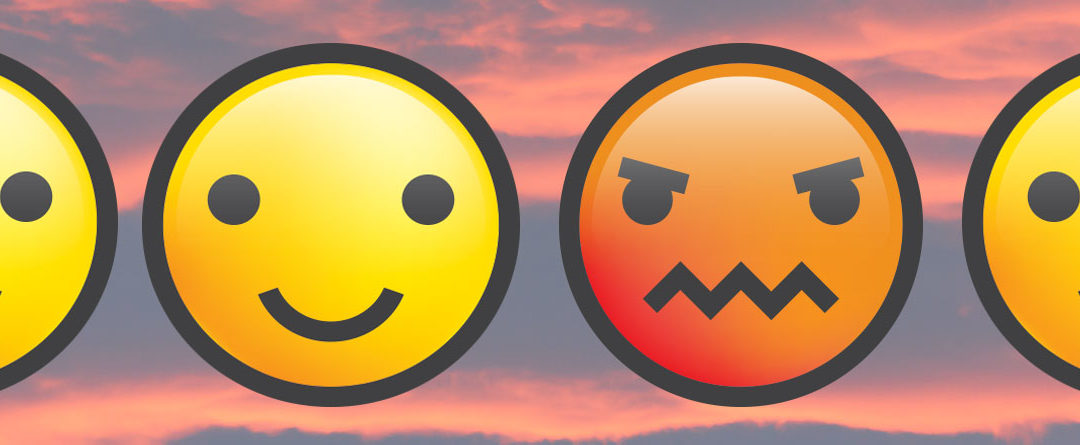by Kristen Glass Perez
When I was a kid, there was an image that always struck terror in my heart. It was a sickly green frowning face with its tongue sticking out, and it clearly meant “stay away!”
Who was this green-faced demon? Well, he was named Mr. Yuk and he was powerful. I knew that he was not to be messed with.
Mr. Yuk is a trademarked graphic created by the Children’s Hospital of Pittsburgh and used to label household chemicals that are poisonous. Mr. Yuk’s green face very clearly expresses disgust, sickness and anger. He appeared on things that lived under our kitchen sink, like bleach and oven cleaner. To this day, his image gives me the creeps.
The vintage emoji
I consider Mr. Yuk to be the precursor to the modern emoji. Do you speak emoji? According to the dictionary, an emoji is a digital image or icon used to express an idea or emotion. In my digital lifetime, I have seen the emoji evolve in rapid succession. Now, I can use an emoji to reflect my choice of wine or shoes. We’ve come a long way from Mr. Yuk!
The premise is the same, though. There is something basic about core emotions like anger, joy and sadness that seems to be easily expressed in graphic shorthand–frowny faces, smiley faces, weepy faces. But while it’s easy to drop a symbol of an emotion into an email, navigating emotions IRL (in real life) can be a more challenging.
Slow to anger
Anger is a natural part of human life, like the other emotions. In scripture, we see many examples of anger.
Psalm 145:8 sings, “The Lord is gracious and merciful, slow to anger and abounding in steadfast love.”
Notice, the text it does not say that God is never angry. The psalmist reminds us that we have a loving, gracious and merciful God, who also can be angry. A natural part of the true depth of life is anger.
The housewives of Biblical times
Long before the Real Housewives of here and there began flipping tables on television, Jesus famously overturned the tables in the temple–in anger.
“In the temple he found people selling cattle, sheep, and doves, and the money changers seated at their tables. Making a whip of cords, he drove all of them out of the temple, both the sheep and the cattle. He also poured out the coins of the money changers and overturned their tables. He told those who were selling the doves, ‘Take these things out of here! Stop making my Father’s house a marketplace!’” (John 2:14-16).
There is a flip side (see what I did there?) to every emotion. Jesus’ anger is triggered by injustice. In flipping the tables, he calls into question practices that were embedded into the culture of the temple. That culture could not be sustained without the exchange of currency and the selling of animals for sacrifice. In this way, Jesus’ anger challenges us to examine our own choices.
Are we and our faith communities using our financial resources to continually reveal God’s presence to our neighbors, or are we doing things simply to sustain our own comfortable practices? We don’t get to the answer without going through anger: anger about what challenges us, anger about what we do or do not want to talk about, anger about something that triggers us unexpectedly.
I like to think that those are some of the things that were simmering in Jesus that day at the temple.
Growling as emoji
My dog gives a warning sign when he’s angry or upset. He growls and the hair on his neck stands up. This is his signal that something isn’t right, and it’s time to pay attention.
I used to scold my dog for growling, but I have learned that scolding just tells my dog that instead of growling a warning, he should act. My dog’s growl seems to be his own built-in emoji or Mr. Yuk sticker. It’s how he lets me know that there’s something out there I need to pay attention to.
 We might think about our own anger similarly. There is no full human experience without anger. We can experience anger with our friends, our family, our children, our co-workers, and even with our faith communities. We might make a point of noticing when we want to utter the human equivalent of a growl, and pay attention to what’s making us feel that way before we act.
We might think about our own anger similarly. There is no full human experience without anger. We can experience anger with our friends, our family, our children, our co-workers, and even with our faith communities. We might make a point of noticing when we want to utter the human equivalent of a growl, and pay attention to what’s making us feel that way before we act.
What causes us to react with anger? Is it injustice? Is it danger? Paying attention to our own emojis will help us live more fully into who God has created us to be. At the same time, we need to pay attention to the emojis that others flash at us. They can be a clue that something big is about to happen.
Like all human beings created in God’s image, we are faced with anger. It comes alongside joy and sadness. Anger is not to be ignored, but instead can be seen as an invitation to be united in and ignited with a passion for justice. Anger is a part of the fullness of humanity. What we do with it is a response to God’s grace.
Closing prayer:
Dear God, thank you for the gift of emotion. Help us to remember that as human beings we have agency in your creation. Help us to use our full range of emotions to respond in love and action to serve and love our neighbors as ourselves. Amen.
Discussion questions:
1. What are some of the triggers you notice about your own anger?
2. When has your anger helped you to be a force for the greater good?
3. When has your own anger made you uncomfortable?
4. What emoji would you like to invent?
The Rev. Kristen Glass Perez is chaplain and director of vocational exploration at Augustana College in Rock Island, Illinois. She speaks emoji daily.


Thank you for such a thoughtful and relevant reflection. Amen and Amen.